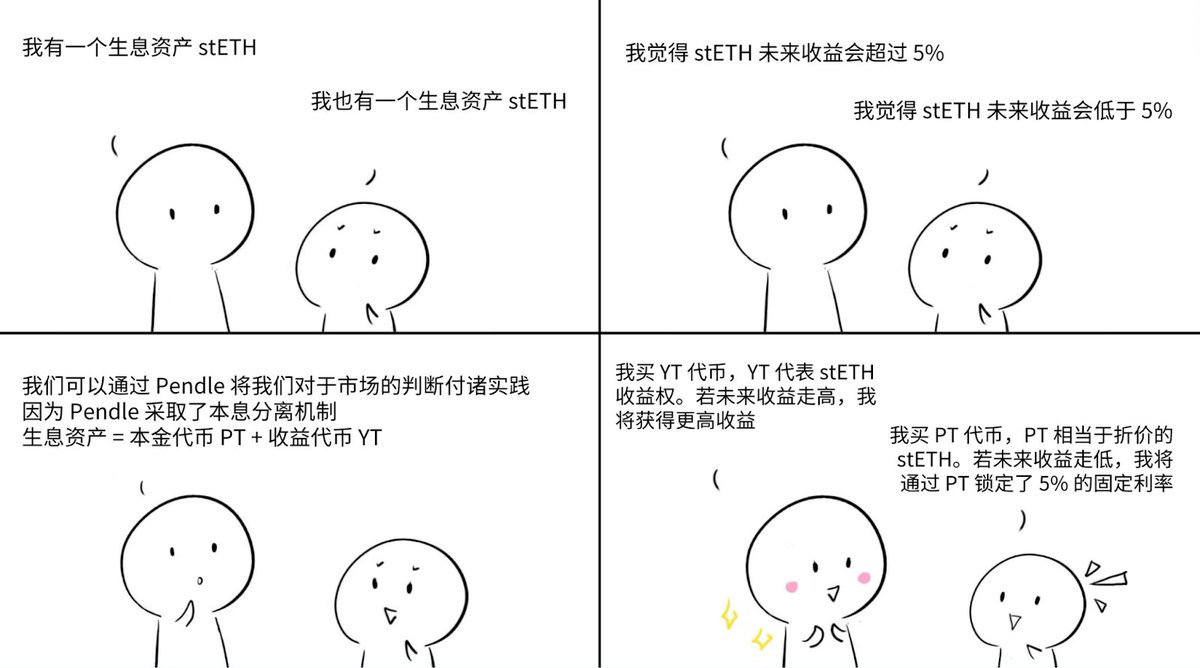A picture is worth a thousand words!
The diagram vividly explains, how does Pendle work? How to make money with Pendle? What is the logic?
It is obvious that it is a game of interest rate ups and downs, and it can also be found that it is very consistent with the logic of trading!
In the future CEX/DEX, there must be a new sector of interest rates, and with Pendle's current absolute leader position in the Web3 interest rate derivatives track, there will be a place for Pendle in the future!
Moreover, in the field of traditional finance, the interest rate derivatives track in which Pendle is located is already very mature.
The last time I thought that interest rate trading would lead to a new exchange product, I didn't know that Pendle was already planning to launch a DEX-like product: Boros.
Once formed, it will be the head product that takes advantage of Pendle's existing strengths (and even if Boros doesn't succeed in the end, the rest of the products will need to be supplemented by the infrastructure provided by Pendle).
However, I am looking forward to more, that is, in the future, the PT/YT tokens split by Pendle can be directly listed on CEX, connecting on-chain and off-chain, forming a new DeFi + CeFi + DEX + CEX TradFi.
Unlike hedging or stablecoin mining, which I have been taking during this time, I have changed a lot of DeFi positions to $PENDLE, and I bet he can do it!
______________________
The core goal of Pendle is to achieve principal and interest segregation, which normalizes these interest-bearing tokens by wrapping yield-generating assets into SY tokens.
The SY token can then be split into two parts: the principal token PT and the yield token YT. Through Pendle's Automated Market Maker (AMM) mechanism, users can easily trade these tokens and realize the game of interest rates.
The principal token PT is like a stable investment tool that can help users resist market fluctuations and lock in fixed returns.
The price of PT tokens is usually lower than the price of the original asset, and this difference is the fixed income that users can receive. Users who buy PT tokens are usually people who are cautious about future earnings and want to lock in current yields through PT.
YT, a yield token, is a leveraged instrument full of opportunities and risks.
Users do not need to invest a large amount of money to buy complete interest-bearing assets, they only need to hold YT to enjoy the right to income generated by the principal.
If future earnings decline, users may face losses; But if the revenue goes up, the user will get a higher return. Therefore, users can flexibly choose to increase or decrease their holdings of YT tokens according to their predictions of future yields to seize market opportunities.

The Next Step for Decentralized Exchanges: Spot/Futures Trading of Interest Rates!
This idea was inspired by @pendle_fi, and when I first came across Pendle, I felt that it was not suitable for traditional DeFi players, but more suitable for traders.
In simple terms, Pendle divides tokens into yield tokens (YT) and principal tokens (PT), which can be used for trading.
That is, the price of YT is not only affected by the return of the local currency, but also by the market.
The game on Pendle is the rise and fall of the future interest rate of the token, and in the current existing transactions, the rise and fall of the local currency are gamed, and the income token is taken out separately, which is also fully applicable to the spot/contract logic of the current exchange.
In the past, the conditions were not too mature, but recently PT and YT have appeared more and more frequently on Twitter and Web3 articles, and many DeFi protocols are innovating based on Pendle, and even many arbitrage games have used PT/YT.
For example, @lista_dao's clisBNB has been launched on Pendle before, and the latest lending can also use PT-clisBNB, as well as the arbitrage play of BERA/BGT for @berachain, and it can also be combined with exchange shorting and holding PT/YT mining arbitrage.
The adoption and support of Pendle by these protocols is likely to make Pendle the next core protocol for DeFi and double $PENDLE in the last month, although it is still a bit from its high.
But as envisioned at the beginning, the next step for decentralized exchanges is spot/contract trading of interest rates.
Pendle's YT is the income part other than the local currency, and theoretically all tokens that can generate interest rates can be split into YT tokens, so make a YT-based exchange completely.
Moreover, YT was born in DeFi, which is naturally more suitable for on-chain and DEX.
As on-chain exchanges are maturing and Pendle adoption is expanding, is the future promising?
In this regard, @Aster_DEX @StandX_Official do you have any plans for the future?
@BTW0205 @degens_grandma @ViNc2453 @PendleIntern @0xNing0x
21.68K
91
The content on this page is provided by third parties. Unless otherwise stated, OKX is not the author of the cited article(s) and does not claim any copyright in the materials. The content is provided for informational purposes only and does not represent the views of OKX. It is not intended to be an endorsement of any kind and should not be considered investment advice or a solicitation to buy or sell digital assets. To the extent generative AI is utilized to provide summaries or other information, such AI generated content may be inaccurate or inconsistent. Please read the linked article for more details and information. OKX is not responsible for content hosted on third party sites. Digital asset holdings, including stablecoins and NFTs, involve a high degree of risk and can fluctuate greatly. You should carefully consider whether trading or holding digital assets is suitable for you in light of your financial condition.

